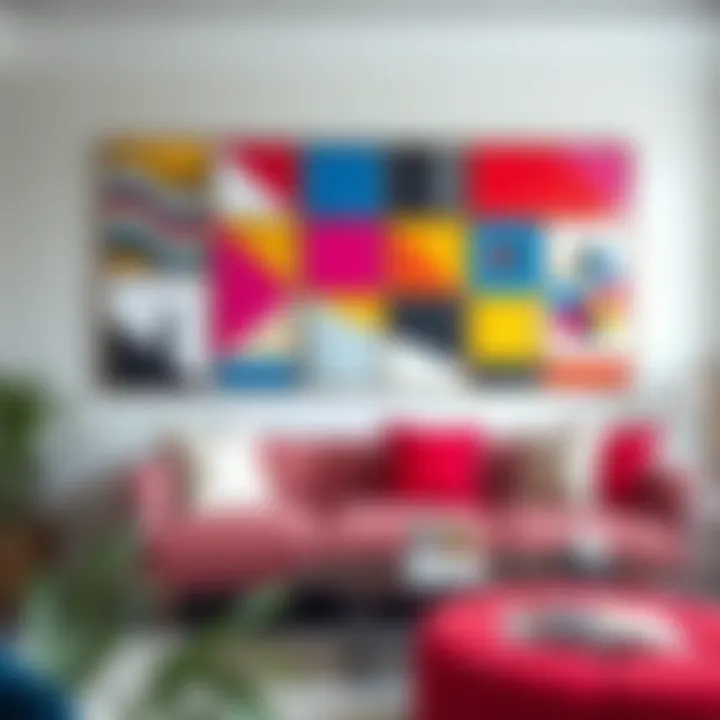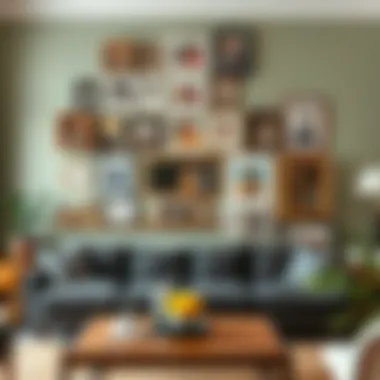Innovative Ideas for Stunning Picture Collages


Intro
Creating a picture collage can be much more than just hanging a bunch of frames on the wall. It’s about telling a story, sharing a vision, or even capturing a plethora of emotions in a single glance. This guide aims to unravel creative concepts for picture collages that not only beautify your walls but also imbue your living spaces with personal meaning and flair. Whether you're a homeowner wanting to spruce up your living room or an interior designer looking for fresh ideas, this article is packed with innovative approaches to elevate wall decor.
Picture collages can vary greatly in style and complexity. From sleek, modern arrangements to rustic, vintage-inspired displays, the options are nearly limitless. The choices we make in layout and themes can transform a mundane area into a conversation starter, turning your walls into canvases for your life’s most cherished memories or the musings of your artistic endeavors. So grab your tape measure, gather your favorite photographs, and let’s dig into how you can create a stunning collage that reflects your unique perspective.
Design Trends
In this section, we’ll explore the distinct styles that can inform the creation of your collage, focusing on both contemporary approaches and vintage inspirations.
Contemporary Styles
In the age of minimalism, the allure of contemporary picture collages often lies in their clean lines and vivid simplicity. Open layouts where negative space plays an integral role not only make the photographs pop but also create a harmonious flow throughout the room. Think of grids that showcase a consistent theme, such as travel, family events, or abstract art concepts, arranged with logical repetition.
Using colors that complement your existing space can amplify the overall aesthetic, offering a serene and organized feel. It’s about creating balance, possibly even integrating some geometric designs with your frames. Mixing different sizes and shapes, yet maintaining a cohesive color palette, can create visual interest without overwhelming the viewer. This style embraces the mantra that less is often more, allowing each piece to shine in its own right.
Vintage Inspirations
On the contrary, vintage-inspired collages offer a whimsical touch, capturing history and nostalgia. This approach could involve selecting old family photographs, sepia-toned prints, or even postcards from travels gone by. Layers of textured frames, ideally in varying sizes, can contribute to that rustic charm, giving a sense of time and storytelling to the wall.
The arrangement can be casual with an eclectic mix, or possibly symmetrically arranged for controlled chaos. Consider using antique-style frames to convey an old-world allure that invites curiosity and conversation. The beauty of vintage collages often lies in their lack of uniformity, allowing for creativity without boundaries. Here, the emphasis is on personal memories intertwined with cherished heirlooms.
"A collage isn’t just about images; it’s about experiences woven into a tapestry that adorns your wall."
Ending
Understanding the trends in design, whether contemporary or vintage, sets the stage for creating a meaningful picture collage. The next step will delve deeper into materials suitable for these concepts, enabling homeowners and decorators alike to choose sustainably while keeping style at the forefront.
Understanding Picture Collages
When it comes to decorating your walls, picture collages offer a unique blend of art and personal narrative. They do more than just fill empty space; they create a vibrant tapestry of memories, emotions, and styles. Understanding picture collages is essential for anyone looking to add a personal touch to their home or workspace.
The Art of Visual Storytelling
At the core of a picture collage is the concept of visual storytelling. Each photo captures a moment, a feeling, or a slice of life, weaving together the threads of your experiences. Think about it: an image of your grandfather fishing on a quiet lake, a snapshot of your travels through the bustling streets of Tokyo, or a candid of you celebrating a milestone birthday. Together, these images can narrate the journey of your life, showcasing significant events and cherished memories.
Visual storytelling taps into the innate human desire to connect through shared experiences. When guests glance at your collage, they don’t just see pictures; they see stories waiting to be uncovered. It makes the wall a conversation starter, inviting stories and memories associated with each image, thus enhancing relationships in the space. In a way, you’re sending a silent yet powerful message—this is who I am, and this is what matters to me.
Importance in Interior Design
In the realm of interior design, picture collages hold considerable weight. They can dramatically influence the tone and ambience of a room. Instead of generic art pieces that don’t resonate with the inhabitants, collages showcase individual personality and taste.
A well-curated collage not only beautifies a wall but also balances the overall aesthetic of a room. A thought-out combination of frame styles, colors, and art forms can draw the eye and create focal points. Uniting various elements like rustic wooden frames with modern prints can yield a juxtaposition that feels fresh yet cohesive.
For designers and homeowners alike, consideration must be given to the space where the collage will inhabit. For larger areas, an expansive salon style may encompass vast canvases alongside smaller prints. In contrast, a more intimate setting, like a bedroom, might call for a snug collection of family snapshots and personal keepsakes that contribute warmth and comfort.
"A picture collage isn't just decor; it’s your life reflected on a wall."
Taking the time to understand picture collages opens the door to countless possibilities for creative expression. Whether you’re a homeowner looking to personalize your space, a designer seeking to delight clients, or a DIY enthusiast considering new projects, recognizing the art and importance behind collages will elevate your wall aesthetics to a whole new level.
Choosing a Theme for Your Collage
Choosing a theme for your picture collage is like picking the perfect frame for a masterpiece. It defines the narrative, resonates with emotions, and sets the overall tone of your visual display. A well-chosen theme doesn’t just enhance the aesthetic; it tells a story, weaving together memories, cultures, and experiences into an artful presentation. This section explores various thematic considerations that will aid in creating picture collages that are both meaningful and visually compelling.
Personal History and Memories
A collage centered around personal history is deeply enriching. It allows you to curate a visual diary, showcasing moments that have significantly shaped your life. Family gatherings, trips, or even candid snapshots from daily life can be artfully arranged to reflect a timeline or meaningful experiences.
Consider using a mix of black and white photos alongside vibrant color images. This juxtaposition adds depth. If you’re feeling adventurous, try cutting shapes from your photos to give them a playful edge—like hearts or stars—adding a personal touch. Remember, authenticity resonates. Each picture should stir a memory or evoke a feeling, creating a rich tapestry of personal anecdotes.
Cultural Influences
Cultural elements lend a rich narrative layer to picture collages. They serve as a bridge between past and present, local and global. For instance, integrating family heirlooms into your collage can be a captivating way to highlight your roots. Images of traditional clothing, festivals, or culinary specialties from your culture can provide context and depth to your visuals.
Think about using artifacts like postcards or tickets from events you've attended that represent diverse cultures. Layer these along with your images for a textured, dimensional effect. This approach not only decorates your wall but also sparks conversations about your heritage, inviting viewers to engage more deeply with your story.
Nature and Landscape Inspiration
Nature-themed collages offer a refreshing escape into the tranquility commonly associated with the outdoors. Doing so allows the incorporation of landscapes, botanical prints, and even textures found in nature, such as wood or leaves. For example, using photos of mountains, beaches, or forests, you can create an immersive experience that transports viewers into different environments.


When composing this type of collage, emphasize colors that mimic those in nature—earthy browns, vibrant greens, and ocean blues will harmonize beautifully. Try framing these nature images in rustic wooden frames, which add to the organic feel. Additionally, integrating actual elements, like pressed flowers or leaves, can create an enchanting three-dimensional effect that invites viewers to interact.
"The beauty of a collage lies in its ability to tell many stories at once, celebrating the diverse elements that shape our lives."
Types of Picture Collages
When it comes to decorating your walls with picture collages, the layout is crucial. Each type of collage has its own flair, affecting how viewers perceive the images you’ve chosen to showcase. The differences in arrangement can evoke emotional responses and even change the dynamics of a space. Some layouts are rooted in tradition while others invite chaos, and understanding these styles helps you make informed choices that resonate with your personal aesthetic. Beyond mere decoration, these collages serve as a form of narrative – each image correlating with another, creating a story that unfolds across your wall.
The Traditional Grid Layout
The Traditional Grid Layout is a classic approach to displaying your images. It consists of several framed pictures arranged in a neat grid, often parallel to the floor and walls, forming a consistent pattern. This layout is often preferred for its clean look, promoting a sense of organization and calm. It can depict a series of portraits, snapshots from a vacation, or even conceptual illustrations.
The layout works well when you wish to maintain uniformity. Each frame can be identical in size, or you can play with minor variations as long as the general layout adheres to a grid. This can be particularly effective in formal settings, like a home office or a dining area, where harmony in design complements the atmosphere of relaxation or focus.
Benefits of Traditional Grid Layout:
- Orderliness: Creates a neat, tidy appearance that’s pleasing to the eye.
- Versatility: Fits well in various themes, from modern to minimalist.
- Focal Clarity: Each picture stands out due to the organized backdrop.
"A well-laid grid can channel energy into a space, guiding the eye from one image to the next without overwhelming sensation."
Salon Style Arrangement
The Salon Style Arrangement takes a bold twist on the grid method. This technique echoes the sophisticated charm of art galleries, layering photographs and artwork in a seemingly haphazard yet curated way. Each piece is distinct in shape, size, and even framing, interspersed on the wall in an eclectic fashion. This style is particularly suited for those who have a diverse collection of artworks or photographs to show off, allowing for a vibrant arrangement that tells a multifaceted story.
When working with this layout, think of it as creating a collage with your entire collection, uniting different genres and themes—as if you’re curating a mini-exhibition in your own home. It’s a conversation starter. The chaos of the arrangement contrasts beautifully with the individual pieces, making the viewer stop and absorb each item thoroughly.
Benefits of Salon Style Arrangement:
- Personal Expression: Allows for showcasing diversity in your tastes.
- Dynamic Dialogue: Creates a lively visual atmosphere that invites exploration.
- Creative Freedom: There are no strict rules; place your favorites wherever they fit best.
Freeform and Organic Display
The Freeform and Organic Display embraces all things spontaneous. Instead of adhering to strict boundaries, this style allows for whimsical arrangements of pictures across a wall. Think of it as an artistic play field where imaginations run wild. Pictures, frames, artifacts, or even shelves with collected trinkets can all be part of the installation, focusing on curating a cozy, lived-in look.
For those with eclectic tastes—vintage pictures, scrapbook elements, and even three-dimensional objects—this style will be a breath of fresh air. It promotes creativity, inviting the viewer to interact with the collage and the stories behind the various pieces. This layout can work wonderfully in informal settings like a family room or a hallway.
Benefits of Freeform and Organic Display:
- Inventive Flair: Breaks the norms of traditional display, lending a unique touch to your wall.
- Interactive Experience: Captivates viewers with a broader range of visuals to explore.
- Warmth: Makes the space feel more inviting, reflecting a homey atmosphere.
Materials and Frames Considerations
When diving into the world of picture collages, the aspects of materials and frames play a more pivotal role than many recognize. Choosing the right components can significantly influence not only the aesthetic but also the durability and overall appeal of your wall decor. Frames are not just supports for your images; they're the boundaries that can elevate a simple photo into a masterpiece, giving it context and breathing life into a theme.
Choosing the Right Frame Sizes
One of the first steps to crafting a visually appealing collage is selecting the correct frame sizes. These frames are the building blocks of your display, so getting them right is crucial. Think of it as balancing a scale; if your frame sizes don't complement one another, the entire installation can feel off-kilter.
- Mixing Sizes: Incorporating various frame sizes adds depth and interest. For instance, pairing a large frame with smaller ones invites the eye to journey across the collage rather than getting stuck in one spot. This can be akin to a well-composed piece of music where different notes create harmony.
- Height and Width Considerations: Consider both the dimensions of your images and the wall space available. A large wall might benefit from oversized frames, while a compact area could get overwhelmed; striking a balance is key.
Some designers also suggest laying the frames on the floor before mounting them on the wall. This gives a clearer picture of how different sizes and shapes work together.
Material Choices: Wood, Metal, and Plastic
Choosing materials for frames can often evoke a certain mood or tone within the space. Let’s break this down:
- Wood: Often favored for its warmth and natural charm, wood frames can bring a rustic feel to your collection. They work wonders in cozy settings, like living rooms or bedrooms, offering a sense of homeliness. Different wood finishes can change how the frames interact with other colors in your décor.
- Metal: A metal frame exudes modernity and sophistication, making it a perfect choice for contemporary or industrial spaces. Available in various colors and finishes, metal frames can be slick and minimalistic or bold and artistic—defining the essence of your display.
- Plastic: While sometimes undervalued, plastic frames are lightweight and economical, making them an excellent choice for more playful or experimental collages. They come in numerous colors and designs, allowing a level of customization that can mirror one’s personality more directly.
Matting and Finishing Touches
Don’t underestimate the power of matting—the often overlooked aspect of framing that can dramatically change the visual impact of your collage.
- Adding Depth: Mats create a visual buffer between the frame and artwork, providing a sense of depth. This can highlight the images, guiding the viewer's attention effortlessly.
- Color Choices: Select colors for the mat that either complement or contrast with the frames and images. For example, a bold color can energize a collage, while softer hues can create tranquility.
- Finishing Touches: Simple accents, like a well-placed decorative nail or unique hangers, can significantly elevate the finished product. These details might be small, but they contribute to the overall polish of the display.
Designing picture collages need not be a drudgery. With thoughtfulness in material choices and a mindful approach to frames, you can transform your wall into a vibrant narrative space. The process offers a tactile engagement with both art and life—painting a more intimate story in your home.
Planning and Layout Techniques
Effective planning and layout techniques are the backbone of creating an engaging picture collage. To truly capture the essence of your visuals, it’s crucial to give thought to the arrangement and spatial dynamics of each piece. Planning goes beyond merely deciding which images to display; it involves a careful consideration of balance, flow, and how each photo or artwork interacts with one another. When executed well, these elements come together to form a cohesive story that resonates with viewers, inviting them to explore the narrative behind your chosen images.
Mock-Ups and Visual Testing


Before hammering any nail into the wall, it's wise to create mock-ups of your collage. This step can save you time and frustration. One effective method is to use kraft paper cutouts in the shapes of your frames. Tape them onto the wall to visualize the arrangement. Take a step back to see how the images play off one another. Do they complement or clash? This approach can help one see if the arrangement feels balanced or if something needs adjustment. You might also consider photographing your setup and analyzing it from different angles. Keep in mind that the height at which you hang your pieces is also important; typically, eye level is the sweet spot.
Spacing and Balance Tips
Finding the right spacing between each piece of art is essential. Too much space can make your collage look disjointed, while too little can create a cluttered feel. A common practice is to start with a uniform gap—about 2 to 4 inches—and adjust from there if necessary. You can play around with these distances to see what visually pleases you. Moreover, balance is pivotal in avoiding visual chaos. Consider the visual weight of your images. Larger pieces should be anchored in the design, possibly flanked by smaller ones to provide equilibrium.
- Rule of Thirds: This classic principle can be a helpful guide when positioning your images. Imagine your wall divided into thirds both horizontally and vertically. Place your focal points along these lines or their intersections to create a dynamic composition.
- Cluster Grouping: Think about grouping images that share a common theme, color, or aspect. This can help unify diverse images into an organized layout.
Focal Points in Design
Identifying focal points in your collage is a key technique for drawing viewers' attention. Focal points can be created through a combination of size, color, and contrast. For instance, selecting a notably larger image or one in a bright color can act as an anchor around which other pieces revolve.
When designing your focal point, ask yourself what you want your audience's eyes to land on first. Should it be a cherished family photo, a piece of art that encapsulates your journey, or perhaps an inspiring quote? Establishing a hierarchy of images will guide the viewer's eye naturally, creating a sense of movement throughout your arrangement. Just remember, too many focal points might confuse the viewer, so aim for clarity.
"A picture collage is more than just an arrangement of images; it's a tapestry of stories woven together on the wall of your life."
In summary, meticulous planning and layout techniques lay the groundwork for a picture collage that tells a compelling story. From the mock-ups to balancing spacing and defining focal points, each step enriches your creative output, ensuring that your wall space transforms into an immersive narrative of who you are.
Incorporating Mixed Media
In the realm of picture collages, incorporating mixed media transcends mere visual aesthetics. It’s about interweaving different artistic expressions into a cohesive narrative. By blending various materials and visuals, you create depth and a story that captivates the eye and mind. This approach not only enriches the appearance of your space but also mirrors a personalized expression that highlights who you are.
The benefits of using mixed media in your collages are plentiful. Firstly, it invites creativity; you are not restricted to only photographs or standard art pieces but can diversify with textures, colors, and forms. Additionally, it helps in establishing a unique voice in your decor that stands out from traditional designs. Consider the warmth of wood frames paired with a sleek metal finish, or combining an abstract painting with family photos for a personal touch. Each element contributes to a rich tapestry of visual storytelling that speaks volumes without uttering a word.
Combining Photographs with Artwork
When you mix photographs with artwork, you craft a conversation between different artistic expressions. Photographs capture moments in time, while art can convey emotion, abstract ideas, or themes. The synergy of these elements can evoke powerful reactions from those who experience them.
Start by selecting a central theme for your collage. For instance, if you focus on family memories, incorporate candid photographs amidst vibrant watercolor paintings that depict family activities or locations you cherish. This not only enhances the visual diversity but also pulls together memories into a thoughtful display of your journey.
Furthermore, the placement of photographs versus art pieces is crucial. By mixing sizes and orientations—perhaps a large family photograph against smaller framed landscape art—you create a dialogic layer that naturally attracts the eye, drawing viewers in to explore the entire arrangement.
Adding Textures and Objects
Textures and objects play a pivotal role in transforming a flat collage into a multidimensional experience. Adding these elements brings life, inviting touch and engagement, while enhancing the visual narrative. Think beyond just basic frames—how about incorporating fabric swatches, leaves, or even small thematic trinkets?
For instance, consider a travel-themed collage: alongside your pictures, affix a piece of a map, a ticket stub, or natural elements like sand or seashells from your travels. These physical pieces tell a story, making your collage feel immersive. They prompt viewers to recall their own experiences, creating a resonance that mere images cannot achieve.
In terms of arrangement, allow the textures to guide the flow of your collage. Layering soft fabrics in corners can provide contrast to hard materials like wood or metal. This interplay visually invites viewers to explore the nuances of your design, enhancing engagement with the pieces you have so carefully chosen.
Mixed media invites creativity and diverse expression, making every wall tell its own unique tale.
Incorporating mixed media into your picture collages is not just about aesthetic appeal; it’s fundamentally an exploration of self-expression, history, and emotions. Each choice informs your viewers about who you are and the stories that define you, ultimately enriching your living space in a way that resonates deeply with personal significance.
Color Theory and Collage Cohesion
In the realm of picture collages, color theory serves as a cornerstone for effective design and visual storytelling. Understanding color dynamics can elevate a simple arrangement of photos into a cohesive narrative that resonates with viewers. Not only does it affect the mood of the space, but it also binds individual elements together, creating a harmonious flow. The essence of color theory lies in its ability to evoke emotions and convey messages that transcend words. When executed correctly, a well-thought-out color scheme enhances the overall aesthetic and functional appeal of your collage, turning your walls into a canvas of personal expression.
Choosing a Color Palette
Selecting a color palette is akin to choosing the right ingredients for a gourmet meal; the balance and harmony play crucial roles. First, consider the existing colors in the room or the overall decor theme. Do you have muted earth tones, or is there a playful pop of color? A color palette should be complimentary, ensuring that the collage feels integral to the room's environment.
One effective method to choose a palette is to utilize the 60-30-10 rule:
- 60%: Dominant color, typically the largest element within your collage, often derived from a landscape or a significant feature in the room.
- 30%: Secondary color, adding depth and contrast, which can be introduced through photo borders or frames.
- 10%: Accent color, a bold hue aimed at catching the eye, perhaps in some artistic elements or smaller photographs within the collage.
For example, if your living room features a mild beige and dark brown color scheme, you might opt for a palette that incorporates deep green as the dominant shade, a lighter cream as the secondary, and a vibrant mustard yellow to accentuate certain pieces. The result is a collage that harmonizes beautifully with the space while adding that necessary flair.
Creating Contrast and Unity
Creating contrast and unity might sound contradictory, yet they are two sides of the same coin in collage design. While it’s essential to craft focal points that draw the eye—a principle rooted in the idea of contrast—achieving unity ensures that the collage doesn’t just feel like a hodgepodge.
To balance these concepts, consider the following:
- Diverse yet Cohesive Elements: Use images with varying backgrounds and color intensities, ensuring they belong within the same general palette. For instance, a faded navy photo complemented by a bright red image can work together when both are framed in black, allowing the frames to unify the disparate images.
- Texture and Materials: Integrate different materials and textures within your collage. The combination of matte and glossy finishes can create visual interest while the chosen colors maintain unity. This method adds depth without overwhelming the senses.
- Consistent Frame Styles: Keeping frames consistent in shape but different in color can also enhance contrast while maintaining unity within your collage. For instance, mixing black and white frames can achieve an edgy look that remains coherent.
"A well-composed color story can breathe life into your walls, turning everyday images into a captivating narrative that speaks louder than words."
In summary, effective use of color theory in your picture collages boosts not only aesthetics but also the emotional impact of your display. By carefully selecting a color palette and thoughtfully balancing contrast with unity, you develop a cohesive visual experience that speaks to your unique narrative and style.
Collage Ideas for Different Spaces


Exploring collage ideas for different spaces is crucial for creating a harmonious and personalized living environment. Each room in a house serves a unique purpose, and the arrangement of pictures can reflect that, enhancing both aesthetics and functionality. A well-thought-out collage in any given space can evoke emotions, stir memories, and enliven an atmosphere, making it an essential aspect of interior design. When considering where to display these collages, thinking about the mood, size, and nature of the room becomes imperative.
Living Rooms and Family Areas
Living rooms and family areas serve as the heart of any home. This is where family and friends gather, share stories, and create lasting memories. Therefore, an effective collage in these spaces should reflect warmth and comfort. When selecting images, consider using photographs from family gatherings, travel memories, or even moments of daily life.
Arranging the images in a cohesive way is key. You might opt for a salon-style arrangement, where frames of various sizes create an energetic vibe, or a more structured grid layout for a calm effect. Introducing varied frames—perhaps a mix of wood and metal—can add depth. Additionally, consider including non-photo elements, like artwork or sentimental artifacts, to deepen the narrative of your collage.
"A well-curated collage can act as a family tree, with branches reaching into moments shared that are worth celebrating."
Bedrooms and Personal Retreats
In bedrooms, the collage can feel more intimate, offering a glimpse into personal tastes and cherished experiences. Since this is a personal retreat, consider incorporating images that resonate deeply with your identity. You might include landscapes that inspire tranquility, quotes that motivate, or personal milestones. The focus here is to nurture a serene and cozy atmosphere.
Placement is vital in bedrooms. Try placing collages above the bed for a centralized focal point or clustered images along a bedside wall for quick glimpses at your personal history. Choosing a color palette that harmonizes with bedroom tones—soft blues or earthy tones—can create a dreamy vibe. Textures also play a role; adding a textured backdrop like a fabric or painted surface can elevate the visual interest of your collage.
Home Offices and Workspaces
In home offices and workspaces, collages can be both motivational and inspiring. Here, images that fuel your creativity or remind you of your goals can be particularly effective. This might mean a mix of professional achievements, images of places you aspire to visit, or motivational quotes that resonate with your work ethic.
For layout, consider integrating a vision board style, where images are intermixed with post-it notes or sketches. It creates a dynamic environment that fosters creativity. Additionally, ensure that the color scheme of the collage aligns with the overall aesthetic of your workspace—calming colors can help maintain focus, while a touch of vibrant color can invigorate your space.
In essence, tailoring your picture collages to the distinct functions and atmospheres of each room not only enriches your home aesthetically but resonates with your personal narrative, making each space uniquely yours.
Maintenance and Updating Your Collage
The beauty of a picture collage lies not just in its initial construction but also in its ongoing evolution. As life moves forward - relationships blossom or fade, trends in decor shift, and new memories are made - your collage should reflect those transformations. This section delves into why maintenance and updating are crucial elements for keeping your wall art not only fresh but also relevant to your current narrative.
Maintaining your collage is about more than just aesthetics; it allows you to stay connected to the stories behind each photo or piece of art. Updating it regularly can breathe new life into your space. It can also be a form of creative expression, offering a canvas to showcase your ever-changing journey. Besides, it can also keep guests engaged, sparking conversation and prompting shared reminiscences.
Important considerations include time management, the emotional connections tied to images, and choosing the right moment to switch things up. By making a habit of revisiting and refreshing your collage, you ensure it continues to resonate with who you are and where you’ve been.
Refreshing Content with New Images
One of the simplest ways to keep your collage feeling fresh is by integrating new images. This practice invites new stories into your space and can genuinely enhance the overall composition. Think about how experiences shape us: a recent family gathering might yield candid photos that spark joy every time you glance at them.
When you decide to refresh your images, consider these steps:
- Identify New Photos: Look through recent events, travels, or daily life snapshots that hold personal significance.
- Evaluate Layout: Before swapping out old images, envision how the new ones will fit into the existing arrangement. A new photo might bring a splash of color or a different mood to the overall piece.
- Rotation Schedule: Develop a system for regular updates. You might agree to change your collage each season. This can keep it dynamic without overwhelming you.
To make the transition easier on the eyes, think about balancing old and new images for a cohesive feel. By blending the past with the present, you're telling an intertwined story.
Cleaning and Care for Frames
A picture collage is only as good as the frames that contain its memories. Frames can gather dust and smudges over time. Regular cleaning not only maintains your collage's aesthetic appeal but it also preserves the integrity of the materials used.
Effective Cleaning Tips:
- Use a Soft Cloth: Microfiber or soft cotton cloths can remove dust without scratching glass or finishes.
- Glass Care: If the frame has glass, a mild glass cleaner is your best bet for a streak-free shine. Avoid ammonia-based cleaners, which can damage certain frame materials.
- Check Frame Integrity: As you clean, take a moment to inspect the frames for any wear and tear. Look out for cracks, loose joints, or discoloration.
By taking a few moments to care for your frames, you ensure that your images have an inviting home. After all, framing a life's journey is about cherishing those moments in a way that showcases their importance.
Final Considerations
When it comes to curating picture collages, the final touches can make or break the overall aesthetic and efficiency of the display. This article emphasizes that these concluding elements are just as essential as the initial design choices. They are not merely about aesthetics, but they serve a deeper purpose in reinforcing the narrative you wish to convey through your images. Personal touches allow for a sense of identity, while evaluating the specific impact of your collage on your surrounding space can transform a simple wall into a gallery that resonates with both you and your guests.
Personal Touches That Matter
Each picture has its own story, and adding personal touches indeed amplifies that story. Including items like handwritten notes, postcards, or even snippets of fabric from a cherished piece of clothing can provide texture and depth to your collage. Using a mix of classic and modern frames enhances visual interest as well as adding a unique flair.
Moreover, family heirlooms or vacation souvenirs can become integral components that spark conversation.
Here are some ideas to consider:
- Incorporating Text: Quotes or phrases that resonate with your journey can enhance the emotional weight of your collage.
- Seasonal Updates: Changing images or items to reflect seasons or milestones keeps your collage dynamic.
- DIY Elements: Handcrafted additions, like small decorative items or art pieces, foster creativity and reflect individuality.
It’s these thoughtful details that ultimately personalize the experience and make the collage feel authentically yours.
Evaluating Impact on Space
After creating your collage, assessing its impact on the space around it is vital. This evaluation questions not just how it looks, but also the feelings and moods it evokes. A well-thought-out collage might add warmth and vibrancy to a cold room, or make a small space feel more intimate.
To effectively assess the space’s response to your collage, consider:
- Light: How does natural and artificial light interact with your images? Are there shadows? Does it enhance or detract?
- Color Harmony: Do the colors of your pictures echo or clash with the existing palette of the room? A harmonious color scheme can unify the decor.
- Flow and Accessibility: Ensure the collage allows for easy movement in the space. It shouldn’t block pathways or interact awkwardly with furniture.
Ultimately, keeping these evaluations in mind ensures your collage complements the room rather than overwhelming it. A carefully curated display can elevate your space, emphasizing the aesthetic at play alongside celebrating your personal stories.















